Ijraset Journal For Research in Applied Science and Engineering Technology
- Home / Ijraset
- On This Page
- Abstract
- Introduction
- Conclusion
- References
- Copyright
Construction of Cement Concrete Pavement Using Paver Blocks
Authors: Roshan Kumar Nayak , Uttam Mandal , Biraja Sankar Pradhan , Prof. Abhijit Mangaraj
DOI Link: https://doi.org/10.22214/ijraset.2023.54124
Certificate: View Certificate
Abstract
Solid unreinforced pre-cast cement blocks concrete paver is a versatile, aesthetically attractive, functional, cost effective and requires little or no maintenance if correctly manufactured and placed. Paver blocks can be used for different traffic categories i.e. Non-traffic, Light-traffic, Medium-traffic, Heavy-traffic and Very heavy traffic. Most concrete block paving constructed in South Africa has performed satisfactorily but there are two main areas of concern: occasional failure due to excessive surface wear, and variability in the strength of blocks. Paving block is a very common and popular method of hard landscaping that is suitable for various applications including: driveways, paths, public utility areas, garage, forecourts and roads etc. After the useful life of paver blocks, demolished ones can be used as recycle aggregate conveniently. This project strictly follows IS 15658:2006 for Paver Blocks. Aggregate which passes from 20 mm sieve and retain on 4.75 mm sieve is going to be used. The removal of contaminants such as reinforcement, paper, wood, plastics and gypsum should be done. Concrete produced with such recycled concrete aggregate is called recycled aggregate concrete (RAC) In rural area the road construction is under progress, flexible & rigid roads are constructed in combination according to need. Generally flexible payments are constructed outside the village boundary. However the rigid payments are laid inside the village portion. It is seen that the cost of rigid payment is quite high as compare to flexible payment. In this study the work is carried out to replace the rigid payments by concrete bock pavers.
Introduction
I. INTRODUCTION
Paver blocks are small flat blocks used to build pavements as well as walls and pillars. These blocks are available in a variety of colours, sizes, and patterns. Typically, paver blocks are porous blocks made by combining varied proportions of cement, sand and tiny stone shards, among others. The seamless interlocking between them makes them strong with fewer chances of breakage. They are in fact, the most popular in exterior pavement applications due to their aesthetic appeal, robustness and lower maintenance cost.
Paver blocks, sometimes referred to as brick paving, are a popular decorative option for laying pavement. They are used mostly in parking areas, street roads, pavements, patios, and kitchen slabs. Generally, paver blocks have one smooth face and one rough face, although certain blocks may be used on both faces. The paver block wall or surface does not require heavy machinery and comes in a variety of colours, making it aesthetically pleasing. Paver blocks, for example, are ideal for pathways on roads where repair work can be done quickly without disrupting the whole area. Furthermore, when redeveloping bituminous roads, the cost is very high. However, the cost of rebuilding the paver blocks road is relatively inexpensive compared to other types of roads.
Nonetheless, paver blocks should be maintained properly. Gravel and bedding sand should be regularly refilled once they are washed away, as there is a possibility of weeds growing between the paver blocks due to the lack of sand.
II. LITERATURE REVIEW
- Muraleedharan et al. (2003): Noted Past and precent population of paver block in india. Devlopment and application of precast paver block the seventies and was continued in the eighties During the late eighties and early nineties, high-strength CBP technique was in practice Concrete Block Pavements (CBPs) in the seventies and eighties suitable for local conditions, as well as efforts in the nineties for introduction and popularization of small-element, high-strength, Interlocking Concrete Block Pavement (ICBP) for special applications, through laboratory studies, construction and monitoring of pavements and standardization work.
- Brožovský et al. (2005): concluded that concrete paver block compressive test determined using non destructive methods like ultrasonic pluses and hardness tester rebound.
- Ling et al. (2006): Noticed Dry density and compressive strength of concrete paving block is affected differently depending on cement and w/c ratio. If the cement content increases relative to the optimum of water in the concrete mixture, resulting in better dry density and compressive strength. Result show that The design strength level ranging from 20 to 33 MPa and 31 to 42 MPa was achieved using w/c ratio from 0.50 to 0.70 for 12 % cement content and 0.45 to 0.65 for 15 % cement content, respectively.
- Nanda et al. (2010): Said that Stone crusher dust is added certain percentage with fine aggregate it added up to 50% by weight so negligible effect on reduction of physical and mechanical properties of paver block and they reduce costs up to 56%.
- Tapkire et al. (2010): Investigated Recycled plastic used in the concrete paver block amount of plastic waste more and the problem for their disposal, so waste utilized in the construction industry, plastic waste like plastic bottles, pallets, carry bags; polypropylene (PP) and polyethylene Terepthalate (PET) were as alternative replacements of a part of the conventional aggregates of concrete. 20% Recycled plastic are used in place of aggregates in concrete, which does not affect the properties of concrete.
- Kalingarani etal. (2012): Concluded that Interlocking concrete paver block (ICPB) is widely used in exterior flooring so aim of the study is making ICPB with the use of maximum industrial waste like fly ash and copper slag.
- Vaz Aaron et al. (2012): found that cement concrete is second most consumed commodity in the world someone generated a large amount of carbon dioxide it is respontibal for global warming effect. Geopolymer concrete used as an option for OPC in precast concrete products. Geopolymer concrete is a eco friendly option for waste stabilization. GPC paver blocks have high compressive strength compared to OPC. They also have high early strength gain curing time 24hours at 60°C and OPC is curing 28 days in water so geopolymer concrete used Benefitly in the manufacture paver block.
- M ravi et al. (2012): This paper analyzed that experimental study on strength characteristics and water absorption of iron ore tailings based concrete paver blocks compared with that of conventional concrete paver blocks. Iron ore tailing is obtained from the mining industry waste handling and disposing them is a problem so used of iron ore in concrete for their improvement in strength. The use of iron ore tailing from 5% to 15% has shown increases in the compressive strength of the concrete compared to normal concrete and 15% to 25% has resulted in lower compression strength compared to that of conventional blocks.
- Gencel et al. (2012): Found that Marble industry produces large amounts of waste marble they causes environmental problems. There are two types one have cementaceous property and others have no cementaceous property, we have partly replaced aggregate with waste marble. Physical and mechanical tests were performed on blocks so produced. The cement type turns out to be an important factor. Paver block with marble waste give economical value in Turkey 1 m3 concrete to produce paving block costs approximately 34 US $. However, when waste marble is used in the ratio of 40%, the cost goes down to approximately 30 US$.
- Raval et al. (2013): Noticed that ceramic industries waste 15% to 30% of total production, there is a pressure on ceramic industries to find a solution for its disposal, so ceramic waste use in construction so The Compressive Strength of M20 grade Concrete increases when the replacement of Cement with Ceramic Powder up to 30% replaces by weight of Cement.
- Thakur et al. (2013): Found that Nylon Fiber to increase the compressive strength of Paver Block. Addition of optimum nylon fiber and fly ash in the construction of paver block increases its compressive strength up to 13.55% as compared to standard mix.
- Kashiyani et al. (2013): Investigated Innovative addition of polypropylene fibers only in the top layer (15 mm) of paver block for determining the change in the compressive strength of paver blocks and reduces the maintenance cost of paver block, 0.4% fiber in the top 15 mm of paver block it improves strength up to 40 %, paver block more dense, more abrasion resistance, more durability and reduce the water absorption percentage.
- Kashiyani et al. (2013): Study said that addition of polypropylene fibers in paver block to so the change in the result of Abrasion Resistance and Flexural Strength of paver blocks improved with compare standard paver block and reduces the maintenance cost of paver block.Mix propotion for concrete paver block used in top layer is 1:3 (Cement: dolomite powder) and polypropylene fibre with the different percentage rate and 1:1:2:3.75 (Cement: Fine aggregate: Semi Grit: Quarry dust) in the bottom layer of paver block and result shown that after 28day percentage of polypropylene 0.3% and 0.4% gives good results for abrasion resistance and flexural strength.
- Santos et al. (2013): Presents this work was to study the use of coal waste to produce concrete paving blocks. Analyzed say that coal is used to replace a conventional sand as a fine aggregate for concrete paving blocks. The demand of conventional sand can be minimized and a part of coal tailings can be used and reducing the volume in coal waste deposits.
- Patel et al. (2013): Found that foundry sand in various engineering applications can solve the problem of disposing of foundry sand and other purposes. Foundry Sand can be used as a partial replacement of cement in supplementary addition, to achieve different properties of concrete. The application of a used foundry sand as a replacement with cement is feasible for strength in interlocking paver blocks. Used foundry sand can be used to prepared low cost temporary structure.
- Kashiyani et al. (2013): Found that The compressive strength and water absorption have good property obtained with the inclusion of PPF in paver block. The addition of a 0.4% fiber mixed On The concrete paver block for compressive strength up to 40% and reduce the water absorption and it makes paver block dense than standard blocks.
- Yeole et al. (2014): Noticed Concrete paving blocks are ideal materials on the footpaths and roads for easy laying, good resist impact value, better look with strength so use rubber pads and adding various percentages of waste steel aggregates in paver blocks gives up to 50% more impact strength than ordinary paver blocks.
- Sarkar et al. (2014): Found that Interlocking concrete block pavement that is laid over a subbase of grouted single size aggregate with stone dust and confined by plastic cell made from thin polyethylene. It was shown that the sub-base material undergo compression before it actually take the stresses from the applied load. The use of jointing sand in the space between the blocks helps in distributing the load and reduces the deflection of concrete block pavement by about 14%.
- Navya et al. (2014): Concluded that Property of paver block with the inclusion of natural fiber like coconut fiber in top 20mm layer added different percentage and the result is a 0.3 % coconut Fiber attends maximum compression strength.
- Navya et al. (2014): Examined in a new era presents concrete paver block fibers are introduced to increase strength, durability and reduction in crakes, so using fibers in the concrete paver block it improves the properties of paver block so polyester fiber added in paver block top 20mm thickness. Result Shown that polyester fiber by 0.4% paver block attains maximum compressive, flexural strengths and minimum water absorption found at 7 and 28 days.
- Mall et al. (2014): Analyzed that Paver Block is a better option for road construction as compared road made of bitumen and gravel in a cost view of the point and better stability. Paver block by using Cement Concrete mixture of Design Mix M35 made with use material 10mm Coarse Aggregate, OPC 43 Grade Cement and Fine Aggregate and paver block are of dimension 200 x 160 x 80 mm. To study this process uses the partial replacement of Cement with Fly Ash in percentage of 0% to 30% respectively, and added Gypsum constantly 2% by weight of cement and Superplasticizer is used as an admixture which is added 2% by weight of cement so find that 25% of fly ash give higher strength and economic value compare to conventional mix.
- Patel et al. (2014): Noticed that foundry sand is technically sound, environmentally safe for sustainable development. Partial replacement of Cement with foundry sand in paver block so determined the change in the compressive strength and cost of paver block maximum replacement 50% so results are water absorption is 2% & compressive strength 23.48 N/mm2 cost of paver block is 20.13% lower than standard mix proportion.
- Sharma et al. (2014): Found that in India brick kiln industries are the third largest industry where the coal is used for baking the clay brick and residue of brick kiln called brick kiln dust. Paver Block is widely used in now a day in various area so partial replacement of cement with brick kiln dust 0% to 30% with maximum superplatiszer 2% so result shows that 15% of cement replaced with brick kiln dust give good and effective result.
- Raja et al. (2014): Analyzed that manufacture sand is The best alternative of Fine aggregate for the concrete paver block. To use of the Manufacture sand, we can achieve compressive strength is 43.80N/mm2 in M30 grade paver size 200mmX200mmX50mm. Manufacture sand is good alternative of river sand and cost is also economical.
- Ganjian et al. (2015): Found that use of cement in production of conventional paver block is approximate 210kg/m3. Portland cement is production is it impacts negatively on the environment due to carbon dioxide emissions. So alternative waste product used in space of cement, alternative material like such as run-of-station ash (ROSA), basic oxygen slag (BOS), ground granulated blast-furnace slag (GGBS), plasterboard gypsum (PG), and cement bypass dust (BPD) to reduce the amount of cement in paving blocks. So used of ROSA up to 60%, GGBS up to 55%, BPD up to 25%, and plasterboard gypsum PG up to 5% by weight can replace Portland cement without having any substantial impact on the strength or durability of the blocks. So used on different alternative material can reduce cement content by up to 30% in comparison to the percent of cement used in factories.
- Neekhra et al. (2015): Concluded that nylon fiber is used to evaluate strength of paver block. Nylon fiber, is high tenacity fibers, nylon fiber is used in construction and Nylon fiber is also thermoplastic polymer. After performing different percentage of nylon fiber in the concrete paver block it is observed that addition of nylon fiber 0.3% with the percentage of cement in concrete it give maximum strength of 7,14, and 21 days of age.
- Revathi et al. (2015): Noticed that used of concrete paver block in road pavement is common. concrete paver block is better option when light weight traffic for that road, concrete paver block is cheap and low manitanced compared to content bituminous road. pre-cast concrete block made with m40 concrete mix proportions. rice husk ash is waste material use in as alternative in a space of fine aggregate with different percentage range 0% to 60%. Density of paver blocks is within the range of 1888-2202 kg/m3 and Density values decreases with increase in Groundnut husk ash. With the use of Groundnut husk ash is suitable making the water absorption is less than 7%.
- Reddy et al. (2015): Study said that concrete paver block is made with material of nylon fiber and risk husk ash give good compression strength. for an optimum dose of nylon fiber and risk husk ash is 0.3% and 20% give maximum strength for the concrete paver block.
- Tiwari et al. (2015): Concluded Solid unreinforced pre-cast cement concrete paver blocks have following property versatile, aesthetically attractive, functional, cost effective and requires little or no maintenance if correctly manufactured and laid. For M40 grade and 80mm thick paver block with varying percentage of nylon fiber 0.1% to 0.5% and fly ash 10% to 30% result shown that nylon fiber 0.3% and fly ash 20% give compressive strength up to18.86% compare to conventional mixture.
- Santhosh et al. (2015): Practiced to make paver block with fly ash and glass powder results say that Higher compressive strength and flexural strength was achieved when 20% cement was replaced by equal proportions of fly ash and glass powder and replace up to 30% so abrasion resistance are seems to be satisfactory and water absorption within in permissible level.
III. THOERY
Over the past decade, the paver block industry has maintained its position as one of the fastest-growing segments in construction technology. In fact, paver blocks have been extensively used in residential and infrastructure projects due to their low maintenance and smooth finish. To know about different types of paver blocks available in the market and their unique benefits, read here.
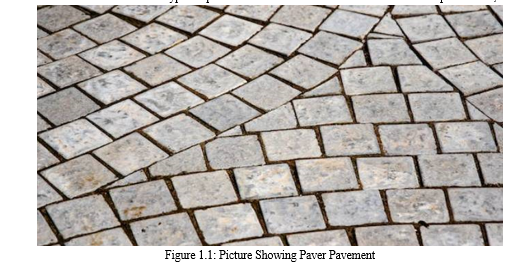
A. Types of Paver Blocks
Paver blocks come in a variety of shapes, including rectangles, squares, zigzags, Xs, interlocking and plain ones and are made up of different materials.
- Clay Paver Block: A clay paver block is an eco-friendly product used mostly to build walls and pillars. It is available in natural shades and does not fade over time.
- Concrete Paver Blocks: Concrete blocks are available in many colours and have smooth and rough surfaces. It is mostly used in places where heavy loads are supported, such as pavement construction.
- Plastic Paver Blocks: Recycled waste plastics are used to make these paver blocks. As a result, they reduce unwanted plastic waste and are environmentally friendly.
- Stone Paver Blocks: To manufacture these types of paver blocks, natural stones are carved and cut and placed on the top of a foundation, which is made of layers of compacted stone and sand.
- Rubber Paver Blocks: These paver blocks are made from recycled rubber and used for constructing an outdoor patio floor covering, deck flooring, pool decking, walkway pathing, and playground flooring. To improve the appearance of rubber paver blocks, often different colours of pigment are added.
- Regular Paver Blocks: Paver blocks of this type are interlocked or packed together without gaps between them. They are installed in all types of parking areas, footpaths and basements where vehicular and human traffic is high.
- Permeable Paver Blocks: As the name implies, they are used to drain the water between them. Often, permeable paver blocks are used in gardens, pathways, and backyards.
B. How are Paver Blocks Made?
Making paver blocks with varying thicknesses is possible with the paver block-making machine. For normal or heavy-duty applications, the blocks come in one or two layers.
- The top layer is composed of white cement, marble powder, marble granules, and colour pigments.
- For strength, the bottom layer consists of cement, sand, and coarse aggregate.
C. Market Dynamics and Growth Potential of Paver Blocks
India's growing construction activities, especially in urban areas, are driving the paver block market. Additionally, homeowners are becoming increasingly interested in beautifying their homes with attractive paved drives and walkways. According to market studies, the paver block segment has experienced steady growth. With the rising demand for hollow concrete blocks, the market is expected to be worth USD 602 billion by 2027. This is a substantial increase compared to just under USD 500 billion in 2019.
Furthermore, the Government's focus on developing infrastructure through Public-Private Partnerships (PPPs) would add to the increasing demand for paver blocks. Nonetheless, paver blocks remain an industry challenge due to a lack of awareness about their
benefits.
D. What is the Paver Block rate per sq ft?
Sanjana Mathur, Co-Founder, Studio Bipolar, Gurgaon, highlights, "Depending on the shapes, sizes, and applications, the cost of paver blocks can vary significantly. For instance, a conventional hexagonal concrete paving block with a thickness of 30 mm can cost around Rs 30 per sq ft, and those with thicknesses over 40 mm might cost more than Rs 130 per sq ft." Also, the cost of paver blocks may vary across locations.
E. Key Benefits of Paver Blocks
- Installation: Experts opine that paver blocks take more time to install. However, they can be used immediately after installation.
- Cost: Paver blocks are expensive upfront if you decide to use them for your home. But in the long run, they may prove cost-effective as they require lower maintenance.
- Weather-friendly: Since paver blocks are small and many of them interlock, they are weather-resistant. As a result, cracks are less likely to form as they can contract and expand.
- Safety: Using paver blocks for outdoor paving is safe. Since paver blocks have a slip-resistant surface, they are safe to drive or walk on during the rainy season. Additionally, these blocks have different textures that do not degrade easily.
- Easy Maintenance: It is easy to clean and mop paver blocks. And as opposed to a chunk of concrete, you do not have to break the slab and replace the entire paver block to repair it.
F. Why are Paver Blocks used in Construction?
Paver blocks, sometimes referred to as brick paving, are a popular decorative option for laying pavement. They are used mostly in parking areas, street roads, pavements, patios, and kitchen slabs. Generally, paver blocks have one smooth face and one rough face, although certain blocks may be used on both faces.
The paver block wall or surface does not require heavy machinery and comes in a variety of colours, making it aesthetically pleasing. Paver blocks, for example, are ideal for pathways on roads where repair work can be done quickly without disrupting the whole area. Furthermore, when redeveloping bituminous roads, the cost is very high. However, the cost of rebuilding the paver blocks road is relatively inexpensive compared to other types of roads.
Nonetheless, paver blocks should be maintained properly. Gravel and bedding sand should be regularly refilled once they are washed away, as there is a possibility of weeds growing between the paver blocks due to the lack of sand.
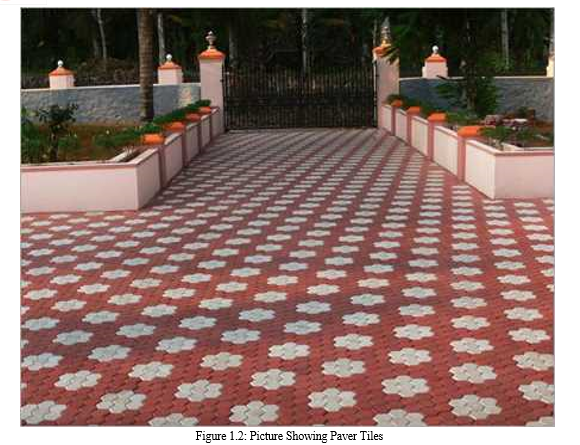
G. Advantages and Limitations
There are many distinct features of ICBP as compared to the conventional methods of pavement construction and hence make it a suitable option for application in the specified areas [7 & 10]. Some of these are:
- Mass production under factory conditions ensures availability of blocks having consistent quality and high dimensional accuracy.
- Good quality of blocks ensures durability of pavements, when constructed to specifications.
- ICBP tolerates higher deflections without structural failure and will not be affected by thermal expansion or contraction.
- ICBP does not require curing, and so can be opened for traffic immediately after construction.
- Construction of ICBP is labor intensive and requires less sophisticated equipment.
- The system provides ready access to underground utilities without damage to pavement.
- Maintenance of ICBP is easy and simple and it is not affected by fuel and oil spillage.
- Use of coloured blocks facilitates permanent traffic markings.
- ICBP is resistant to punching loads and horizontal shear forces caused by maneuvering of heavy vehicles
- Low maintenance cost and a high salvage value ensures low life cycle cost.
However, important limitations of the technique are the following:
a. Quality control of blocks at the factory premises is a prerequisite for durable "ICBP"
b. Any deviations of base course profile will be reflected on the "ICBP" surface. Hence extra care needs to be taken to fix the same.
c. High quality and gradation of coarse bedding sand and joint filling material are essential for good performance.
d. "ICBP" over unbound granular base course is susceptible to the adverse effects of poor drainage and will deteriorate faster. "ICBP" is not suited for high speed roads (speed above 60 km/h)
H. Physical Requirements
Since zero slump concrete is used in production of paver blocks, the quality of blocks produced will depend upon various parameters like the capacity of compaction and vibration of machine, grade of cement used, water content, quality of aggregates used, their gradation and mix design adopted, additives used, handling equipment employed, curing method adopted, level of supervision, workmanship and quality control achieved, etc. Recommended grades of paver blocks to be used for construction of pavements having different traffic categories.
I. Application of ICBP Technology
Some of the proven areas where ICBP technology is being applied are listed below [9 & 10]:
a. Non-traffic Areas: Building Premises, Footpaths, Malls, Pedestrian Plaza, Landscapes, Monuments Premises, Premises, Public Gardens/Parks, Shopping Complexes, Bus Terminus Parking areas and Railway Platform, etc.
b. Light Traffic: Car Parks, Office Driveway, Housing Colony Roads, Office/Commercial Complexes, Rural Roads, Residential Colony Roads, Farm Houses, etc.
c. Medium Traffic: Boulevard, City Streets, Small Market Roads, Intersections/Rotaries on Low Volume Roads, Utility Cuts on Arteries, Service Stations, etc.
d. Heavy and Very Heavy Traffic: Container/Bus Terminals, Ports/Dock Yards, Mining Areas, Roads in Industrial Complexes, Heavy-Duty Roads on Expansive Soils, Bulk Cargo Handling Areas, Factory Floors and Pavements, Airport Pavement, etc.
J. Shapes and Classifications
There are four generic shapes of paver blocks corresponding to the four types of blocks.
- Type A: Paver blocks with plain vertical faces, which do not key into each other when paved in any pattern,
- Type B: Paver blocks with alternating plain and curved/corrugated vertical faces, which key into each other along the curve/corrugated faces, when paved in any pattern,
- Type C: Paver blocks having all faces curved or corrugated, which key into each other along all the vertical faces when paved in any pattern and
- Type D: 'L' and 'X' shaped paver blocks which have all faces curved or corrugated and which key into each other along all the vertical faces when paved in any pattern.
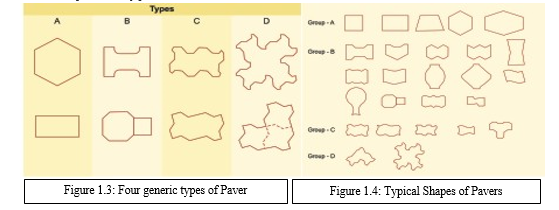
The generic shapes and groups of paver blocks identified to four types are illustrated in Figures 1.3 & 1.4.
K. Materials
The quality of materials, cement concrete strength, durability and dimensional tolerance of paving blocks, etc. is of great importance for the satisfactory performance of block pavements. These aspects and the block manufacturing process itself, which immensely affect the quality of paving blocks, have been outlined in the Indian Roads Congress Special Publications [9]. The Central Road Research Institute (CRRI) has prepared the specifications for ICBP [10]
L. Paving Blocks
The quality of materials, strength of cement concrete and durability as well as dimensional tolerances etc. are of great importance for satisfactory performance of block pavement. The recommended thickness of block and grades of concrete for various applications and specification for paving in which materials used for preparation of blocks, physical requirements, physical test methods, sampling and acceptance criteria has already been formulated in BIS Code [10].
Construction of Interlocking Concrete Block Pavement
- Installation of sub-surface drainage structures
- Leveling and compaction of subgrade
- Provision and compaction of sub-base course (where needed)
- Provision and compaction of base-course and checking for correct profile
- Installation of edge restraints
- Provision and compaction of coarse bedding sand
- Laying of blocks and interlocking
- Application of joint sealing sand and compaction
- Cleaning of surface
M. Construction of Sub–grade
This is the foundation layer over which the block pavement is constructed. Like in conventional pavements, the water table level should not be at a level of 600 mm or higher, below the subgrade level. It should be compacted in layers of either150 or 100 mm thickness guidelines [10]. The prepared subgrade should be graded and surface dressed to a tolerance of ± 20 mm of the design levels, and its surface evenness should have a tolerance of within 15 mm under a 3 m straight edge.
IV. EXPERIMENTAL WORK
A. Construction of Sub–grade
This is the foundation layer over which the block pavement is constructed. Like in conventional pavements, the water table level should not be at a level of 600 mm or higher, below the subgrade level. It should be compacted in layers of either150 or 100 mm thickness guidelines [10]. The prepared subgrade should be graded and surface dressed to a tolerance of ± 20 mm of the design levels, and its surface evenness should have a tolerance of within 15 mm under a 3 m straight edge [10].
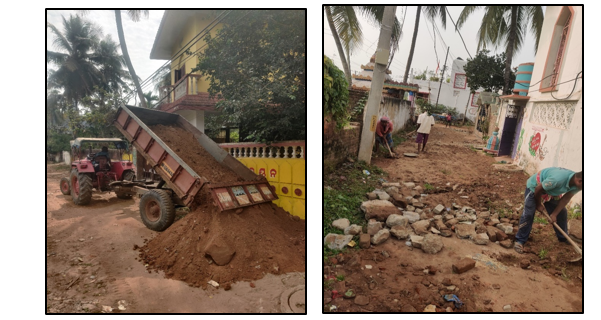
B. Construction of Base and Sub-base Layers
Base course and sub-base course are constructed in accordance with standard procedures contained in relevant IRC specifications like IRC:SP:49-1998, IRC:50-1973, IRC:51-1992, IRC:63-1976, IRC:19-1997 & IRC:37, 2001, [11, 12, 13, 14, 15 & 17]. When cement bound base is proposed it may be constructed using rolled lean concrete as IRC:SP-49. The quality control specified in IRC: SP-11 [16] shall apply. Constructing the lower layers to proper level
and grade is very essential to maintain the top surface level and surface regularity of the block pavement surface.
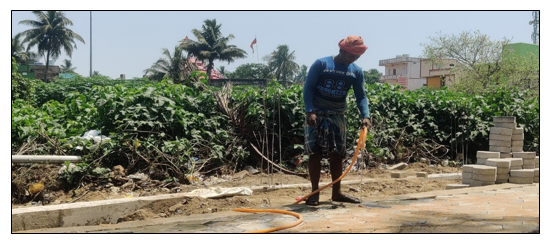
C. Placing and Screeding of Bedding Sand
The thickness of the sand bed after compaction should be in the range of 20-40 mm [10], whereas, in the loose form it should be 25 to 50 mm. It is preferable to restrict the compacted thickness to 20-25 mm to reduce the risk of any localized over-compaction, which would affect the final block surface level. Bedding sand should not be used to fill-up local depressions on the surface of a base or sub-base. The depressions if any, should be repaired with same base or sub-base material in advance before placing sand. The sand of specified gradation to be used, should be uniformly in loose condition and should have uniform moisture content. Optimum moisture content is that when sand is neither too wet nor too dry and has moisture of 6 to 8 percent. Requirement of sand for a day's work should be prepared and stored in advance and covered with tarpaulin or polythene sheets. The processed sand so obtained is spread with the help of screed boards to the specified thickness. The screed boards are provided with nails at 2-3 m apart which when dragged gives the required thickness. The length of nail should take into account the surcharge to be provided in the uncompacted thickness.
Install 1" of Bedding Sand
Clean, sharp concrete sand, 1" deep, should be used for the sand bedding. To determine the amount of sand needed, allow 1 cubic yard of sand per 300sqft. For help estimated the amount of product needed, contact an RCP Block & Brick near you.
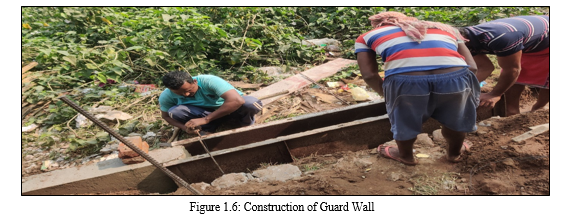
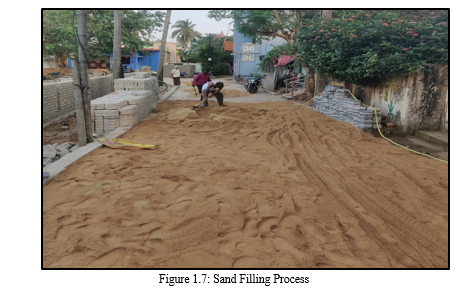
TIP: "Screeding" - In order to get a 1" depth of bedding sand, use two pieces of 10' long 3/4" metal pipe (outside diameter will be 1") and a straight wood 2x4. Lay the pipes parallel to each other, directly on the base material, and approximately 6' apart. Loosely spread a layer of bedding sand over these "screed pipe" so that it fills slightly above the top of the pipe. This will avoid compaction before the pavers are laid. Positioning yourself between the pipes. Place a wood 2x4 perpendicular across the screed pipes. Slowly pull the 2x4 towards you while sliding the wood right and left in a repetitive motion. This will help to level the sand more accurately. This process will leave a one inch layer of sand. Remove screeding pipes and fill in void with loose sand. Remove any excess sand.
IMPORTANT: Do NOT walk on or disturb screeded sand bed.
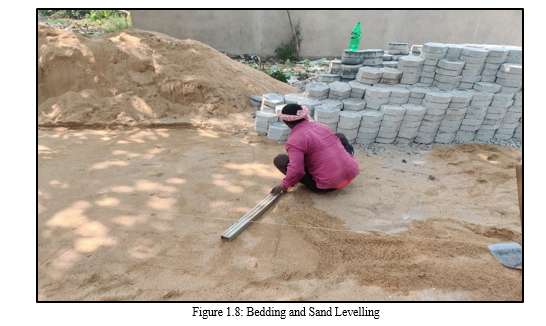
D. Edge Restraint
A stable edge restraint is necessary to eliminate any lateral movement of your pavers and sand bedding. Edge restraints can be either and existing hard edge (such as the side of a house), vinyl molded restraint, or a concrete restraint.
- Installing the Edge Restraint: If an existing hard edge restraint (such as the side of a house) does not exist, you will need to either install a pre-manufactured polyethylene restraint such as "Edge-Pro: or install a concrete restraint.
- Edge-Pro: Use Edge-Pro Paver Restraint on the edges and curves. Secure the edging to the base material using long landscape spikes. These edges can be put in place prior to the laying of the field pavers.
E. Concrete Restraint
To achieve correct height, concrete restraints should be installed after paver field is laid, but just before you reach the position of where the edge restraint will be. Pavers are "wet set" into concrete to create a concrete border. Use 2 parts Class II Road Base to 1 part cement; add water and mix until workable; or use pre-blended concrete mix . Trowel into place. Concrete restraints should be a minimum of 8" wide x 7" deep.
F. Laying the Pavers
It is now time to begin laying the pavers onto the bedding sand and fitting them into the desired area of your paver project.
Field and Border Stones:
When laying the pavers onto the bedding sand, you want to work in a forward motion. Start the process in either a 90° corner or within the field by using a pre set string to guide straightness of pavers. Do NOT step on the bedding sand.
Place pavers flat on the sand bed. Do not tilt the pavers into place as this will disturb the level of the bedding sand. When a row or pattern is in place, use them as a guide for subsequent pavers. The spacing between the pavers should be hand tight (pavers have built-in spacers on their edges to provide a 1/8" joint).
PRO TIP: When laying pavers, check every few feet with a string line to maintain a straight line.
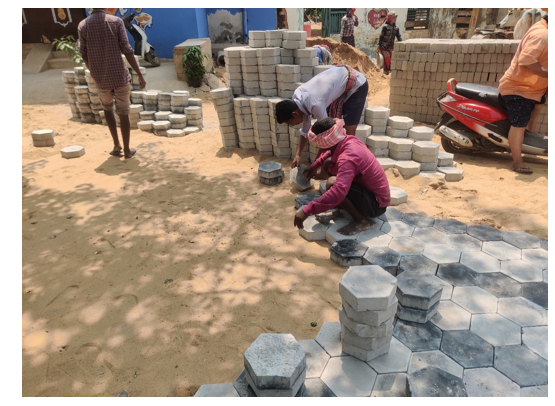
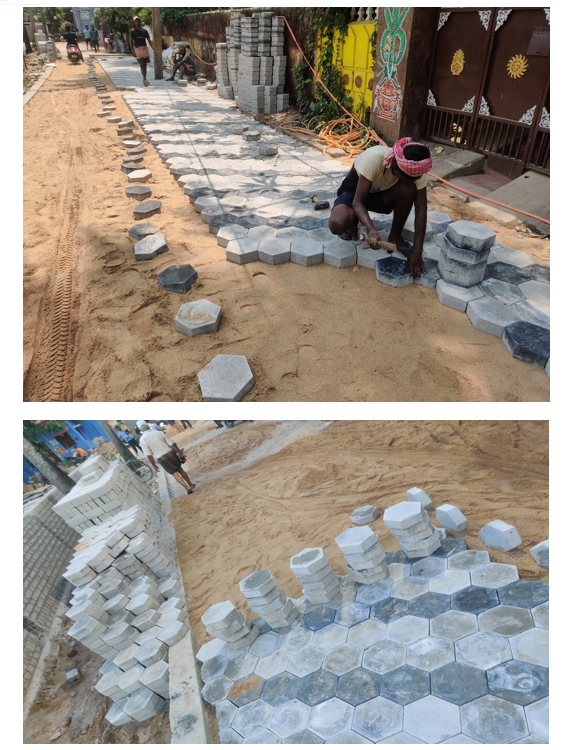
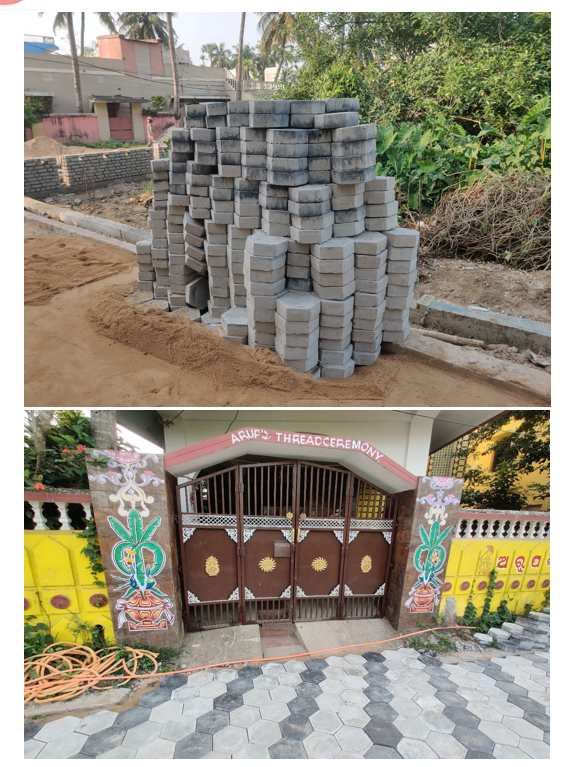
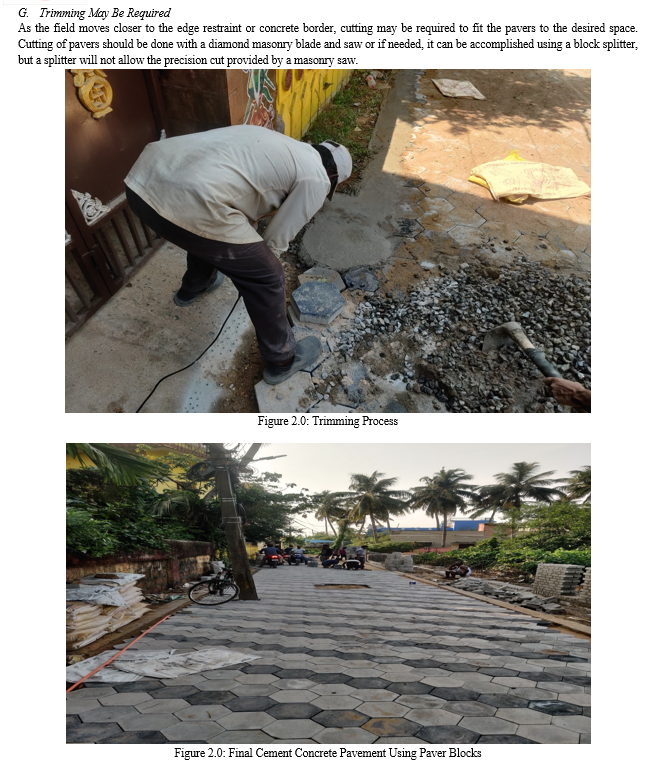
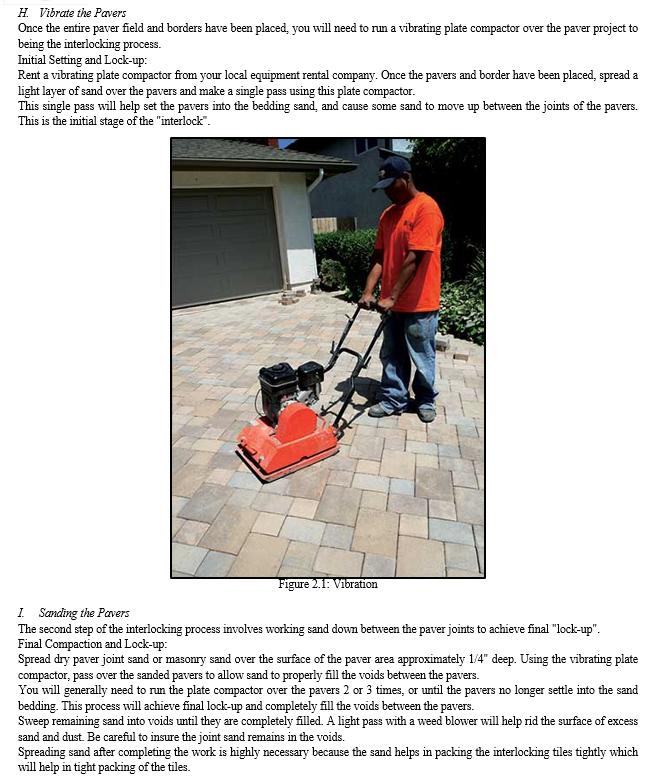
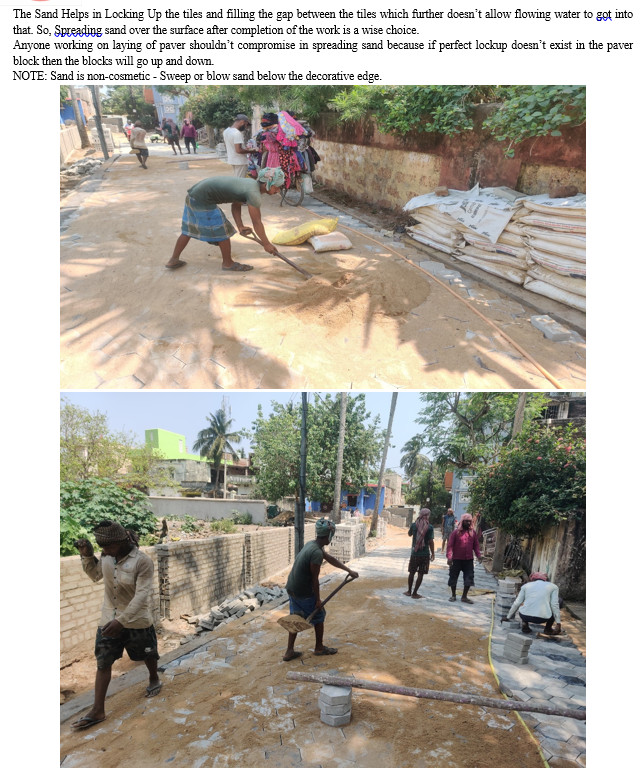
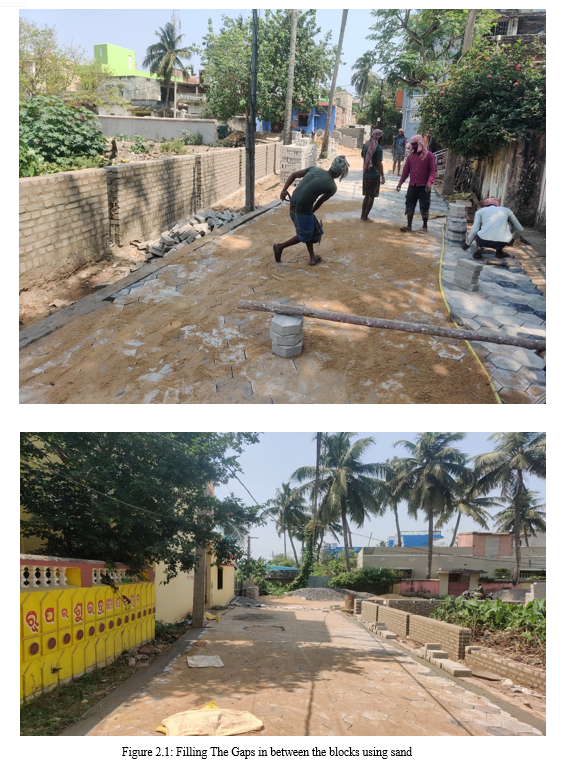
V. FUTURE SCOPE
The best part about the paver block market is that it serves a variety of sectors, and as such, paves the way for tapping into numerous applicable segments (including residential and industrial).
Usually, paver blocks are made from concrete that is poured into forms. These blocks can be used to create any type of surface, including brick pavers, flagstone pavers, stamped concrete, etc. For that reason, they are available in various sizes and shapes, and they have different textures to them. There are many types of pavers available such as:
- Brick Pavers: Brick pavers are usually rectangular or square-shaped with smooth surfaces. They are often used to pave sidewalks, patios, entryways, and driveways.
- Flagstone Pavers: Flagstone pavers are flat stones that are set in mortar. They are generally larger than traditional bricks and can be used to pave pathways, driveways, steps, and walkways.
- Kerbstone Pavers: Kerbstones are similar to flagstone pavers, but they are smaller and more compact. They are typically used to pave parking lots and other outdoor areas.
- Stamped Concrete Pavers: Stamped concrete pavers are usually rectangular in shape and feature a textured surface. They are commonly used to pave parking lots, driveways, walkways, and patio floors.
The paver block market is projected to grow at a CAGR in excess of 4% between 2021 and 2026. In addition, it is also expected to witness significant growth during the forecast period due to increasing construction activity across India. Thus, it wouldn’t be an exaggeration to say that the market will continue its upward trajectory in the coming years.
As per geographical distribution, North America is expected to remain the largest regional market for paver blocks. However, Asia Pacific is expected to register the highest CAGR during the forecast period.
India's growing construction activities, especially in urban areas, are driving the paver block market. Additionally, homeowners are becoming increasingly interested in beautifying their homes with attractive paved drives and walkways. According to market studies, the paver block segment has experienced steady growth. With the rising demand for hollow concrete blocks, the market is expected to be worth USD 602 billion by 2027. This is a substantial increase compared to just under USD 500 billion in 2019.
Furthermore, the Government's focus on developing infrastructure through Public-Private Partnerships (PPPs) would add to the increasing demand for paver blocks. Nonetheless, paver blocks remain an industry challenge due to a lack of awareness about their benefits.
Conclusion
The paver block industry is experiencing tremendous growth owing to several factors such as increasing construction activities, improving living standards, and changing consumer preferences. These factors have led to increased demand for paver blocks from both residential and commercial sectors. Furthermore, the construction sector is expanding rapidly in countries such as China, India, Japan, South Korea, Russia, Brazil, Mexico, Saudi Arabia, and Turkey. India, in particular, is one of the fastest-growing economies in the world; therefore, the country would contribute massively to the overall growth of the paver block market. We\'ve come to the end of our overview of paver block. Due to the high demand for these paver blocks, various construction companies across the globe have begun to invest in paver block making machines to provide the best paver blocks. Furthermore, they are able to reach a larger audience and produce a significant amount of income. Knowing the popularity and features of paver blocks, if you also want to manufacture paver blocks, you should select the best paver block making machine. Steel Land Machinery Works is a leading and reputed manufacturer of block and brick making machines in India. We provide a paver block making machine at the best price. We export our machines across the world and are renowned as the best brick & block making machine exporters from India.
References
[1] Mohan D.M, Vignesh, Utilization of plastic bags in pavement blocks. Volume:119, No15 ,1407-1415 ISSN: 1314-3395.,(2018) [2] V. Natraj “Utilization of Waste Plastics as a Partial Replacement of Coarse Aggregate in Concrete Blocks, ISSN:0994-5645, Vol:08, Issue:12, June (2015). [3] Joel Santhosh. Ravikant Talluri.Manufacture of Interlocking Concrete Paving Blocks with Fly Ash and Glass Powder. International Journal of Civil Engineering and Technology, ISSN:55-64, Vol:06, Issue:04 (2015). [4] R.L. Rame, Recycled plastics used as coarse aggregate for constructional concrete, project reference no 37S1114, ISSN:2319-8753, Vol:02, Issue :03, March (2013). [5] Ganesh Tapkire. Satish Parihar. Pramod Patil. Hemra, R. Kumavat,Recycled Plastic used in Concrete Paver Block. International Journal of Research in Engineering and Technology, ISSN:2321-7308: Vol.3, Issue 09, (2014). [6] B.Shanmugavalli, B. Eswara Moorthy, Reuse of Plastic Waste in Paver Blocks, ISSN:2278-0181: Vol. 6 Issue 02, February-(2017). [7] Raghatate Atul M,Use of plastic in a concrete to improve its properties, ISSN2249–8974 IJAERS/Vol. I/ Issue III/April-June, 2012/109-111 [8] Praveen Mathew et al, Utilization of plastic bags in concrete block, Literature Review, Volume 2, Issue 6 JETIR ISSN-2349- 5162.June( 2015).
Copyright
Copyright © 2023 Roshan Kumar Nayak , Uttam Mandal , Biraja Sankar Pradhan , Prof. Abhijit Mangaraj. This is an open access article distributed under the Creative Commons Attribution License, which permits unrestricted use, distribution, and reproduction in any medium, provided the original work is properly cited.

Download Paper
Paper Id : IJRASET54124
Publish Date : 2023-06-16
ISSN : 2321-9653
Publisher Name : IJRASET
DOI Link : Click Here
 Submit Paper Online
Submit Paper Online

